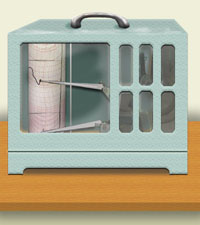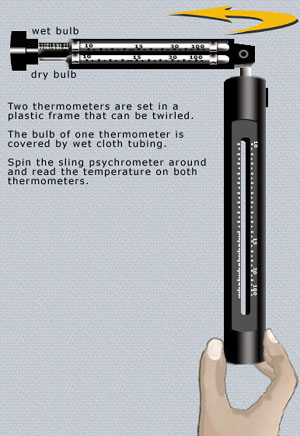Monitoring
The continuous monitoring of temperature and humidity is extremely important whether or not the library/archive has climate control systems. In buildings with a heating, ventilation and air conditioning (HVAC) system, its performance can be monitored and corrective action taken when needed. If the library does not have an HVAC system, an accurate record of temperature and humidity through all seasons and conditions can provide the essential data for designing a future system and can indicate where and when remedial action should be taken.
Monitoring at its simplest consists of taking regular readings of a thermometer and a hygrometer, calibrated with a psychrometer, and noting the changes throughout the day. Although there are now sophisticated instruments for checking temperature and humidity—such as hand-held electronic hygrometers that measure both—these tend to be labor-intensive and not used at night or during holidays. This is also the disadvantage of basic thermometers, dial-type hygrometers, and humidity strips. Automatic monitors, such as recording hygrothermographs and electronic data-loggers, are more useful.
Data-Loggers
Digital data-loggers have replaced recording hygrothermographs as the most popular automatic monitors in libraries and archives. Data-loggers range from simple battery-operated devices that register temperature and humidity and must be regularly downloaded into a computer to sophisticated instruments that are connected to the Internet and can monitor factors such as temperature, humidity, light intensity, and pollutants. Many data-loggers come with software to graph and interpret readings and to produce reports about the long term conditions in an area. Data-loggers should be recalibrated periodically according to manufacturer’s instructions.
Recording hygrothermographs
 A recording hygrometer is an instrument that records temperature and humidity by inscribing the levels with pens on a paper chart fastened to a rotating drum. The drum can be powered by clockwork, battery, or directly from an electrical power supply. There are various designs, but all feature charts that are marked into hours, days, and weeks. The pens are attached to levers, which are activated by metallic thermometer and hair bundles or diaphragms. The hair or diaphragm stretches or contracts to measure humidity, while a pen records the level and rate of fluctuation on the moving chart.
A recording hygrometer is an instrument that records temperature and humidity by inscribing the levels with pens on a paper chart fastened to a rotating drum. The drum can be powered by clockwork, battery, or directly from an electrical power supply. There are various designs, but all feature charts that are marked into hours, days, and weeks. The pens are attached to levers, which are activated by metallic thermometer and hair bundles or diaphragms. The hair or diaphragm stretches or contracts to measure humidity, while a pen records the level and rate of fluctuation on the moving chart.
The advantage of the recording hygrothermograph is that, if properly used, it provides a graphic and long-term record of conditions. Maintenance must be performed regularly if an accurate record is to be kept. The paper charts must be collected and changed every week, the two pens charged with ink, the hair bundles or diaphragm regularly replaced because of wear and tear. At least monthly, calibration with a psychrometer must be done.
Psychrometer
 A psychrometer has two built-in thermometers to determine humidity. One thermometer (the dry bulb) measures the ambient (room) temperature, and the other thermometer (the wet bulb) is wrapped in an absorbent material moistened with distilled water. To obtain a reading, air is passed through the psychrometer to evaporate moisture on the wet bulb. The rate of evaporation is dependent on the amount of moisture in the air. When the moisture has evaporated, a reading of the temperature on the wet bulb is taken, as the process of evaporation will have cooled it. The readings on the dry bulb thermometer and the wet bulb thermometer are then compared and used to determine the actual humidity.
A psychrometer has two built-in thermometers to determine humidity. One thermometer (the dry bulb) measures the ambient (room) temperature, and the other thermometer (the wet bulb) is wrapped in an absorbent material moistened with distilled water. To obtain a reading, air is passed through the psychrometer to evaporate moisture on the wet bulb. The rate of evaporation is dependent on the amount of moisture in the air. When the moisture has evaporated, a reading of the temperature on the wet bulb is taken, as the process of evaporation will have cooled it. The readings on the dry bulb thermometer and the wet bulb thermometer are then compared and used to determine the actual humidity.
There are several types of psychrometer, the most popular for libraries and archives being the sling version, which is the least expensive and easiest to operate. The instrument is rapidly spun for several minutes to impel air through it. Psychrometers must themselves be calibrated from time to time, and procedures must be followed to the letter in order to obtain reliable information. Misreadings can be caused by over-wetting the bulb, under-rotating the sling, exposing the instrument to strong light, and handling the instrument without gloves.